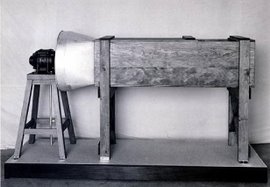So, another coincidence is that shortly after I moved to LA I went to an audition at the American Film Institute and as I was on the winding driveway I saw Corita's colors. And then her name. The Corita Art Center. I had completely forgotten she even spent any time in LA. Then, a little over a month ago, shortly after moving to a part of Los Feliz (an especially green, pretty unique and sort of 'intellectual' funky part of LA next to Silverlake and Griffith Park) ... while on a run one day I ran by the Convent that Corita had lived in. The Sisters of the Immaculate Heart of Mary. It was literally a stone's throw from my new house. What a special presence here.
Corita was like a godmother to me and many of the other women in my family. She was a mentor to my Aunt Sara, who's art now finds itself manifest in a sucessful fashion line (www.SaraCampbell.com), she was the one of first real artists I knew closely, she was the first 'old' person I really knew (and wasn't afraid of), and, she was the first person I felt close to who died. I remember visiting her in the hospital when I was 6 and she had cancer quite bad and she was playing with me still and making me laugh. She gave me some of her breathing tubes and other parapharnalia and I remember taking it home and playing in the bath with it, and pretending that my dolls had Cancer but were at a water spa and were going to get better because of a Dr. Corita.
Anyway, the tanks she painted were very close to where I lived from age 5 to 18 in the Dorchester section of Boston. I would see them all the time and smile and feel 'the world is an amazing place' every time. There was a lot of artwork by her in the apartment, and then house, I lived in growing up too. I don't have pictures of the paintings which accompanied these lines but a few of my favorite pieces had the following written on them in her very specific flowing cursive...
"The crocuses always come up."
"After ecstasy, the laundry."
"Of love,
be
(a little)
more careful
than of anything"

DORCHESTER
Belatedly, Dot says tanks, Corita
Kent's creation now embraced, and analyzed
By Michael Corcoran, Globe Correspondent | October 21, 2007
It has been more than 36 years since Corita Kent painted the Boston Gas tank on Commercial Point, but the intrigue over the colorful work of art has not waned.
Now, it's even the topic of scholarly discourse.
The work, which Kent designed to represent "hope, uplifting, and spring," will be the subject of a panel discussion next Saturday on "the art of Corita Kent and the history of the Rainbow Gas Tank." The event is being held by the Dorchester Arts Collaborative and Dorchester Historical Society at the Savin Hill Yacht Club, and is open to the public.
"It seemed to me that we should celebrate the fact that we have, right here in our neighborhood, the largest piece of copyrighted public art in the world," said Joyce Linehan, chairwoman of the arts collaborative.
The event will feature a panel discussion with artists and others familiar with the Kent's art, and on public art in general. It will cover the life of Kent, who died of cancer in 1986 at age 67, as well as the history of the tank, which Mickey Myers, a friend of Kent, described as "a sign of hope that we are not alone."
The painting was commissioned in 1971 by then-Boston Gas president Eli Goldstone, who thought it would be good to turn the two gas tanks into a work of art.
The design on the 140-foot-high tank features a vibrant rainbow splash and is easily visible from the Southeast Expressway. The original tank was torn down in 1992 and the painting was recreated on the remaining tank, now owned by National Grid.
"I think it is an interesting example of a piece of public art that has been closely identified with Boston," said Ricardo Barreto, executive director of Urban Arts at the Massachusetts College of Art and Design, who will moderate the forum. "It's a piece that people were skeptical about initially, but has since become a symbol of the city to some extent."
Part of this skepticism may have stemmed from the whispers that Kent intentionally inserted a silhouette of Ho Chi Minh, the longtime Vietnamese revolutionary leader, to make an antiwar message. This idea has made the iconic piece of art somewhat divisive. When the original tank was torn down in 1992, veterans' groups demanded the design not be included in the replacement.
Kent denied that Ho's likeness was on the painting, and many doubt the validity of interpretations to the contrary.
According to Alexandra Carrera, director of the Corita Art Center in Los Angeles, Kent's style wasn't well-suited to concealing an abstract representation of someone's face. "There was nothing really meticulous about her paintings," said Carrera. "I don't think there was anything to the rumors."
Myers, who is executive director of the Bryan Memorial Gallery in Jeffersonville, Vt., also said there is nothing to the rumors.
"I can tell you from [seeing] those earliest sketches there was never any intention or goal to create a portrait of anyone or to make any form of political statement in Corita's brush strokes."
But controversies aside, the painting has persisted through the years as a slice of quintessential Boston. Paul White, who in the early '70s served as state senator for the district in which the tank is located, said that while constituents initially didn't know what to make of the eccentric design, it has grown on the people of Dorchester.
"It's a real unique community icon, it has an identity, and it is so different from public construction, which can be so bland," said White, who will take part in the panel discussion. "It has endured because, despite its age, it continues to be a fresh image."
"Anyone from the community will instantly recognize the gas tanks," said Barreto.
"The traffic reports even cite the tanks when giving traffic reports. It is really a piece to celebrate, and I think people would be really disturbed if it were gone."







No comments:
Post a Comment